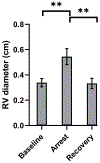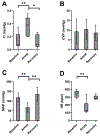Venous waveform analysis detects acute right ventricular failure in a rat respiratory arrest model
- PMID: 36042330
- PMCID: PMC9971354
- DOI: 10.1038/s41390-022-02278-3
Venous waveform analysis detects acute right ventricular failure in a rat respiratory arrest model
Abstract
Background: Peripheral intravenous analysis (PIVA) has been shown to be more sensitive than central venous pressure (CVP) for detecting hemorrhage and volume overload. We hypothesized that PIVA is superior to CVP for detecting right ventricular (RV) failure in a rat model of respiratory arrest.
Methods: Eight Wistar rats were studied in accordance with the ARRIVE guidelines. CVP, mean arterial pressure (MAP), and PIVA were recorded. Respiratory arrest was achieved with IV Rocuronium. PIVA utilizes Fourier transform to quantify the amplitude of the peripheral venous waveform, expressed as the "f1 amplitude". RV diameter was measured with transthoracic echocardiography.
Results: RV diameter increased from 0.34 to 0.54 cm during arrest, p = 0.001, and returned to 0.33 cm post arrest, p = 0.97. There was an increase in f1 amplitude from 0.07 to 0.38 mmHg, p = 0.01 and returned to 0.08 mmHg, p = 1.0. MAP decreased from 119 to 67 mmHg, p = 0.004 and returned to 136 mmHg, p = 0.50. There was no significant increase in CVP from 9.3 mmHg at baseline to 10.5 mmHg during respiratory arrest, p = 0.91, and recovery to 8.6 mmHg, p = 0.81.
Conclusions: This study highlights the utility of PIVA to detect RV failure in small-caliber vessels, comparable to peripheral veins in the human pediatric population.
Impact: Right ventricular failure remains a diagnostic challenge, particularly in pediatric patients with small vessel sizes limiting invasive intravascular monitor use. Intravenous analysis has shown promise in detecting hypovolemia and volume overload. Intravenous analysis successfully detects right ventricular failure in a rat respiratory arrest model. Intravenous analysis showed utility despite utilizing small peripheral venous access and therefore may be applicable to a pediatric population. Intravenous analysis may be helpful in differentiating various types of shock.
© 2022. The Author(s), under exclusive licence to the International Pediatric Research Foundation, Inc.
Conflict of interest statement
Figures






Similar articles
-
Venous Waveform Analysis Correlates With Echocardiography in Detecting Hypovolemia in a Rat Hemorrhage Model.Semin Cardiothorac Vasc Anesth. 2021 Mar;25(1):11-18. doi: 10.1177/1089253220960894. Epub 2020 Sep 21. Semin Cardiothorac Vasc Anesth. 2021. PMID: 32957831 Free PMC article.
-
Peripheral Intravenous Waveform Analysis Responsiveness to Subclinical Hemorrhage in a Rat Model.Anesth Analg. 2023 May 1;136(5):941-948. doi: 10.1213/ANE.0000000000006349. Epub 2023 Apr 14. Anesth Analg. 2023. PMID: 37058731 Free PMC article.
-
Peripheral Venous Waveform Analysis for Detecting Hemorrhage and Iatrogenic Volume Overload in a Porcine Model.Shock. 2016 Oct;46(4):447-52. doi: 10.1097/SHK.0000000000000615. Shock. 2016. PMID: 27070329
-
Congestive kidney failure in cardiac surgery: the relationship between central venous pressure and acute kidney injury.Interact Cardiovasc Thorac Surg. 2016 Nov;23(5):800-805. doi: 10.1093/icvts/ivw229. Epub 2016 Jul 15. Interact Cardiovasc Thorac Surg. 2016. PMID: 27422971 Review.
-
Contemporary management of acute right ventricular failure: a statement from the Heart Failure Association and the Working Group on Pulmonary Circulation and Right Ventricular Function of the European Society of Cardiology.Eur J Heart Fail. 2016 Mar;18(3):226-41. doi: 10.1002/ejhf.478. Eur J Heart Fail. 2016. PMID: 26995592 Review.
Cited by
-
A new method to predict return of spontaneous circulation by peripheral intravenous analysis during cardiopulmonary resuscitation: a rat model pilot study.Intensive Care Med Exp. 2024 Nov 12;12(1):102. doi: 10.1186/s40635-024-00679-8. Intensive Care Med Exp. 2024. PMID: 39531090 Free PMC article.
References
-
- Morray JP et al. Anesthesia-Related Cardiac Arrest in Children: Initial Findings of the Pediatric Perioperative Cardiac Arrest (Poca) Registry. Anesthesiology 93, 6–14 (2000). - PubMed
-
- McMahon CJ et al. Preterm Infants with Congenital Heart Disease and Bronchopulmonary Dysplasia: Postoperative Course and Outcome after Cardiac Surgery. Pediatrics 116, 423–430 (2005). - PubMed
-
- de Boer JM, Kuipers IM, Klitsie LM, Blom NA & Ten Harkel AD Decreased Biventricular Longitudinal Strain Shortly after Congenital Heart Defect Surgery. Echocardiography 34, 446–452 (2017). - PubMed
Publication types
MeSH terms
Grants and funding
LinkOut - more resources
Full Text Sources
Medical

